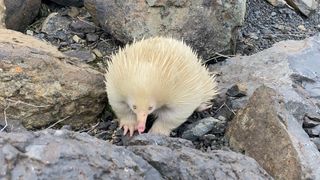Between a state-of-the-art gravitational-wave detector coming back to life and the discovery of a 3,000-year-old bakery still covered in flour, the world of science thrilled us again with another week of groundbreaking news. And nothing is more groundbreaking right now than the combined mass of 1,084,954 buildings in New York City, which are literally sinking the city at a rate of about 0.08 inches (2.1 millimeters) per year.
Speaking of heavy objects, paleontologists in Argentina discovered the remains of a giant long-necked titanosaur that measured about 30 meters long. The dinosaur fossils were so heavy that they caused a traffic accident and smashed the asphalt on the road while being transported to Buenos Aires for study. Thankfully, no bones, human or dinosaur, were broken.
After all, we know life is full of little mysteries (and we should know a thing or two about them), but what’s really got us this week is whether octopuses have nightmares, what China is dropping in space, and whether we ever will Find evidence of a “dark matter star”. However, we’re now a little more certain about the answer to evolutionary scientists’ chicken-and-egg equivalent — which came first, the honeycomb jelly or the sea sponge?
picture of the week
A picture of the all white echidna Raffie spotted in New South Wales, Australia. (Image credit: Bathurst Regional Council)
This unusual little critter is an extremely rare albino echidna, one of two known mammals in the world (alongside platypus) in which the females lay eggs but also produce milk. This all-white, quill-covered creature was spotted on a street in New South Wales, Australia, earlier this month and was dubbed Raffie by local authorities.
Albinism is a genetic condition that affects the body’s production of melanin, the main pigment that colors the skin, coat, feathers, scales and eyes of animals. When melanin cells aren’t working properly, it can cause animals to appear partially or completely white.
“An albino echidna is a rare sight,” officials from Australia’s Commonwealth Scientific and Industrial Research Organization (CSIRO) wrote in a May 22, 2022 Twitter post. “It’s also quite unusual to spot a non-albino echidna,” officials added.
weekend reading
And finally…
The James Webb Space Telescope continues its amazing journey of uncovering mysteries of our universe and discovers a gigantic geyser on Saturn’s icy moon Enceladus, hurling water hundreds of kilometers into space – could it contain chemical ingredients for life?

